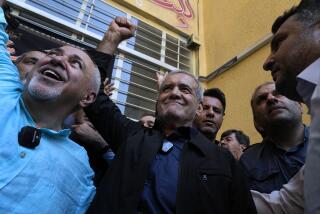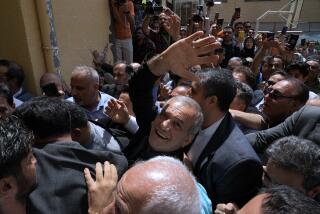Persian Icons Regain Favor in Modern Iran
- Share via
KISH ISLAND, Iran — It started small -- a few babies named after the pre-Islamic heroes Darius or Cyrus, a bit more government money for preserving ancient sites, advertisers using the image of the ruins of Persepolis to sell salad dressing and motorbikes.
Now comes modern Iran’s most audacious salute yet to a Persian past that Islamic fundamentalists would rather forget.
It’s a $125-million hotel built in the style of Persepolis, all graceful columns, statues of winged bulls with human faces and bas reliefs showing envoys bearing gifts for ancient Achaemenian kings -- decorations that violate Islam’s ban on graven images.
“The glory of ancient Persia has been revived. It is the rebirth of Persepolis,” tourist Hasan Ezzati said after visiting the new Dariush Grand Hotel on the Persian Gulf tourist island of Kish. The name reflects the modern Farsi pronunciation of Darius, the ancient king.
After the 1979 Islamic revolution, hard-line clerics opposed any symbols from Iran’s pre-Islamic days. Few resources were funneled to ancient sites, including the palaces and citadels of Persepolis, a U.N.-designated World Heritage Site about 440 miles south of Tehran.
The ruling clerics particularly disdained Persepolis. The late Shah Mohammad Reza Pahlavi, who hosted the rich and famous at a lavish party amid the ruins in 1971 to commemorate 2,500 years of Iran’s monarchy, had linked his legitimacy as king to Persepolis and the Achaemenian era.
“The destruction of two ancient Buddha statues in Afghanistan by the then-extremist Taliban in 2001 reminded me of calls by rigid clerics after the revolution to destroy Persepolis,” said Kamal Adib, an Iranian businessman.
Historian Baqer Choubak says the sheer weight of Iran’s history and public opposition persuaded clerics to gradually support ancient monuments, rather than destroy or neglect them.
“People simply didn’t accept that Iran’s history began after the advent of Islam. That rigidity has loosened in recent years, though there is still a degree of resistance,” Choubak said.
Public interest in Iran’s history rose as the fervor from the 1979 Islamic revolution waned and then a wider disillusionment with clerical rule set in.
The government’s initial rejection of Iran’s pre-Islamic past lessened with the realization that ancient monuments could draw tourists and boost the struggling economy. Fears also eased among Islamic leaders that a monarchy with ties to the ancient past would somehow return.
Clerics are now more likely to insist that history since the arrival of Islam in the 7th century should be emphasized, not that pre-Islamic history should be ignored.
The government allocated $5 million to Persepolis this year for restoration work, pollution protection, new facilities for visitors and promotion of the ancient city as a tourist destination. The big jump from last year’s allocation of just $62,000 came after experts warned of irreparable damage to the site unless strong steps were taken.
In further evidence of changed attitudes, the government has dropped its ban on parents registering such pre-Islamic names for children as Darius or Cyrus, another ancient king. Images of Persepolis and the tomb of Ferdowsi, Iran’s ancient epic poet, turn up on T-shirts, salad dressing and other products.
State TV, although controlled by Islamic hard-liners, shows images of Persepolis and other ancient sites, and filmmakers shoot scenes at such locations.
Opposition has not totally disappeared. The ultraconservative weekly newspaper Ya Lesarat said President Mohammad Khatami should not have attended the April inauguration of the Dariush Grand, thereby giving approval to “the un-Islamic appearance of the hotel.”
Mainland Iran may not be as ready as Kish for the architecture of the Dariush Grand. The island has become a freewheeling weekend getaway where Iranian men and women can stroll or swim in clothes that would be barred elsewhere in Iran as too revealing.
“I feel I’m regaining a lost identity. Tourists visit ruins of Persepolis in southern Iran, but here they see the relic’s undamaged modern image,” Marzieh Masaebi said as she toured the hotel.
In a demonstration of their support for the project owned by Hussein Sabet, an expatriate Iranian billionaire, authorities in Kish have named the square nearest the hotel the same name -- after Darius, a king of the Achaemenid dynasty that was established around 500 BC and was the first significant kingdom of ancient Persia.
“We simply can’t remove the name of our ancestors because we don’t like it,” said Mohammad Alavi, who designed the hotel. “It’s part of our history. It’s Iran’s symbol, identity.”
More to Read
Sign up for Essential California
The most important California stories and recommendations in your inbox every morning.
You may occasionally receive promotional content from the Los Angeles Times.













